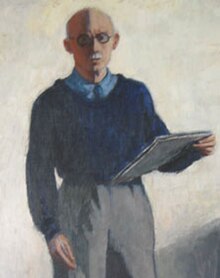Hermann-Paul
| René Georges Hermann-Paul | |
|---|---|

René Georges Hermann-Paul
|
|
| Born |
December 27, 1864 Paris |
| Died | June 23, 1940 (aged 75) Saintes-Maries-de-la-Mer |
| Nationality | French |
| Known for | Artist and Illustrator |
René Georges Hermann-Paul (December 27, 1864 – June 23, 1940) was a French artist. He was born in Paris and died in Saintes-Maries-de-la-Mer.
Recent efforts to catalog the work of Hermann-Paul reveal an artist of considerable scope. He was a well-known illustrator whose work appeared in numerous newspapers and periodicals. His fine art was displayed in gallery exhibitions alongside Vuillard, Matisse and Toulouse-Lautrec. Early works were noted for their satiric characterizations of the foibles of French society. His points were made with simple caricature. His illustrations relied on blotches of pure black with minimum outline to define his animated marionettes. His exhibition pieces were carried by large splashes of color and those same fine lines of black. Hermann-Paul worked in Ripolin enamel paint, watercolors, woodcuts, lithographs, drypoint engraving, oils, and ink.
On the eve of the First World War, he made quite an impression as part of M. Druet's "First Group." As noted by the Burlington Magazine for Connoisseurs, the exhibition was "chiefly remarkable for a series of paintings or drawings - it is hard to say which - by M. Hermann-Paul in a new medium which is simply ripolin." The Great War soon intervened and Hermann-Paul would document its tragedy as well as its foibles. After the war, he underwent several stylistic changes. In his later years, he produced many works in dry point and ink depicting his beloved Camargue.
Between 1890 and 1914 he worked as a lithographer (both in color and in black and white) and as an illustrator for weekly publications such as La Faridondaine, Le Courrier Français, Le Cri de Paris, Le Figaro, Le Petit Bleu, Gil-Blas and Le Rire. Despite great elegance and beauty, his work was imbued with social criticism from the start. Although the bourgeoisie received the brunt of his mockery, Hermann-Paul prodded all aspects of Parisian society. He was critical of rich and poor alike. He attacked monarchs, paupers, politicians, clerics and elements of the established order. Peripheral players in the art world received particular attention.
...
Wikipedia
